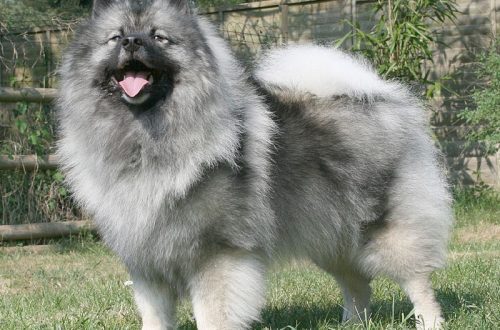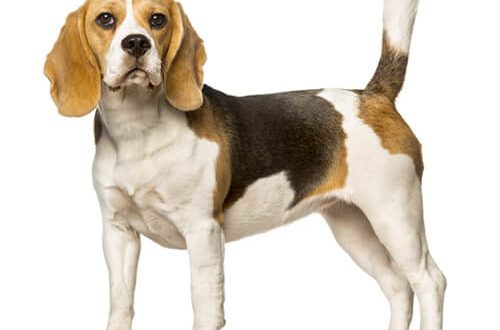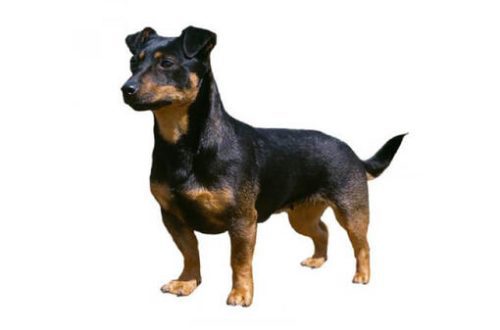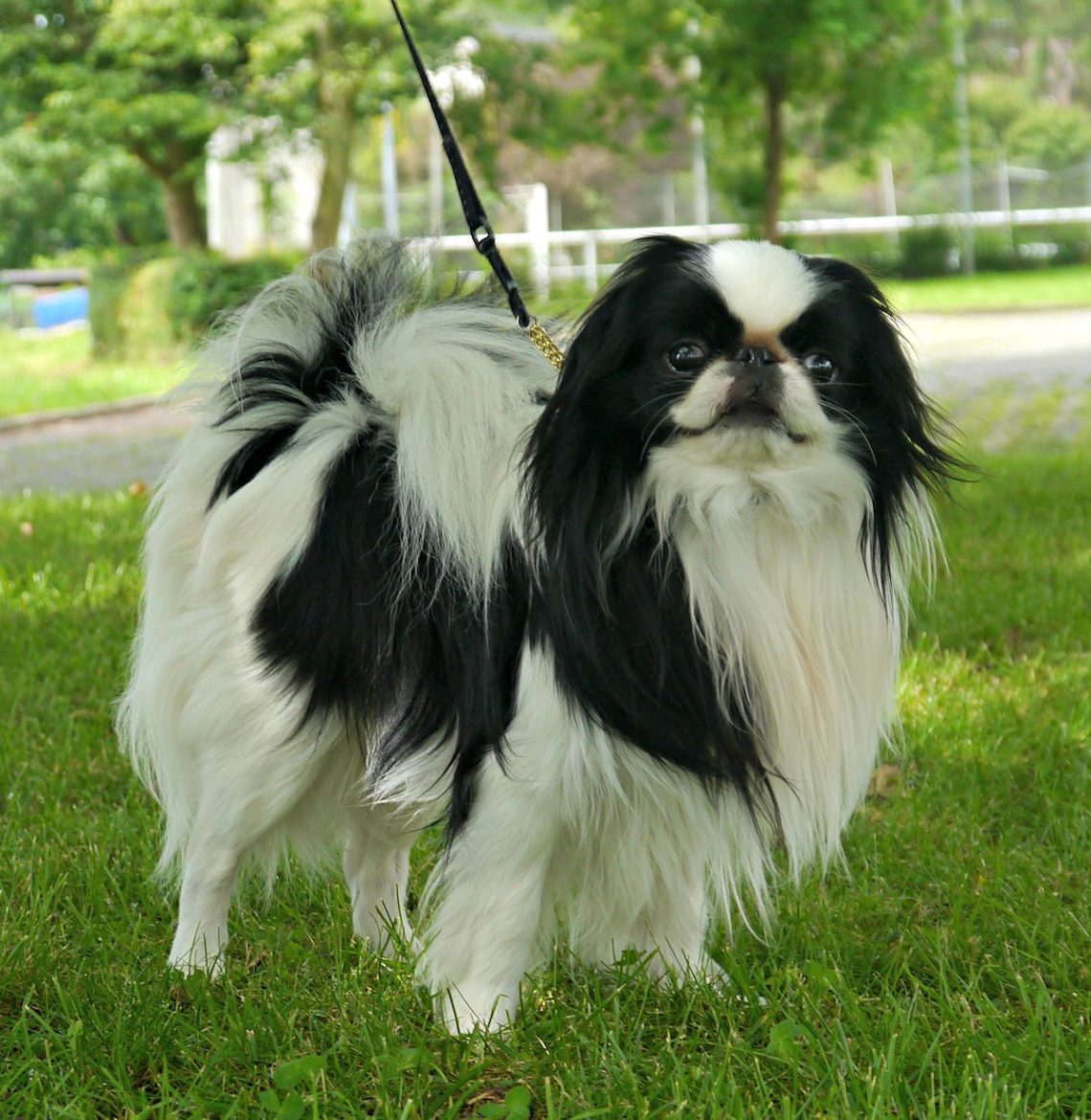
Japanese Chin
Other names: chin , japanese spaniel
The Japanese Chin is a miniature, elegant companion dog. She is smart, understanding, affectionate, perfectly adapted for keeping in small city apartments.
Contents
- Characteristics of Japanese Chin
- Basic moments
- History of the Japanese Chin
- Video: Japanese Chin
- Appearance of the Japanese Chin
- Photo of Japanese Chin
- Character of the Japanese Chin
- Education and training of the Japanese Chin
- Care and maintenance
- Japanese Chin health and disease
- How to choose a puppy
- Photo of Japanese Chin puppies
- How much is the Japanese Chin
Characteristics of Japanese Chin
| Country of origin | Japan |
| The size | small |
| Growth | 20-28 cm |
| Weight | 1-5 kg |
| Age | under 16 |
| FCI breed group | decorative and companion dogs |
Basic moments
- Elegance and grace are the main features of the exterior of Japanese chins. A special charm is given to them by silky long hair.
- Pets of this breed are the most calm and balanced among other small decorative dogs.
- Japanese Chins are suitable for most owners because they have the ability to fully adapt to their lifestyle. They do not require a lot of space, they do not have the habit of “walking with their tail” behind the owner, they are very delicate.
- The pet is active, playful, but not excessively, it needs minimal physical activity.
- Incredibly clean and does not require increased attention to personal care.
- The Japanese Chin is cheerful, friendly, devoted to all households, gets along well with children, but it is not recommended to keep him in a family where there is a child under 6 years of age, as he can inadvertently injure the animal.
- Chin is friendly to other pets. Both the cat and the giant dog are considered by him as friends and possible partners for fun games.
- With its habits, a miniature dog resembles a cat: it can make sounds similar to meowing, hiss, and climb high surfaces.
- With a funny appearance, the Japanese Chin does not allow himself to be treated like a toy and cannot stand familiarity. He establishes contact with strangers with caution, does not like it when they try to stroke him.
- Being an incredibly cheerful creature, openly expressing love for all family members, the hin needs reciprocal feelings. Showing indifference and rudeness to him is unacceptable.
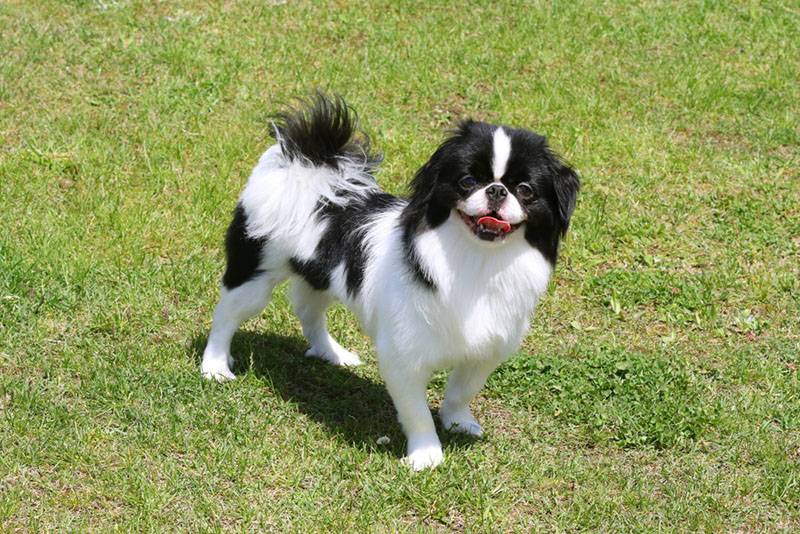
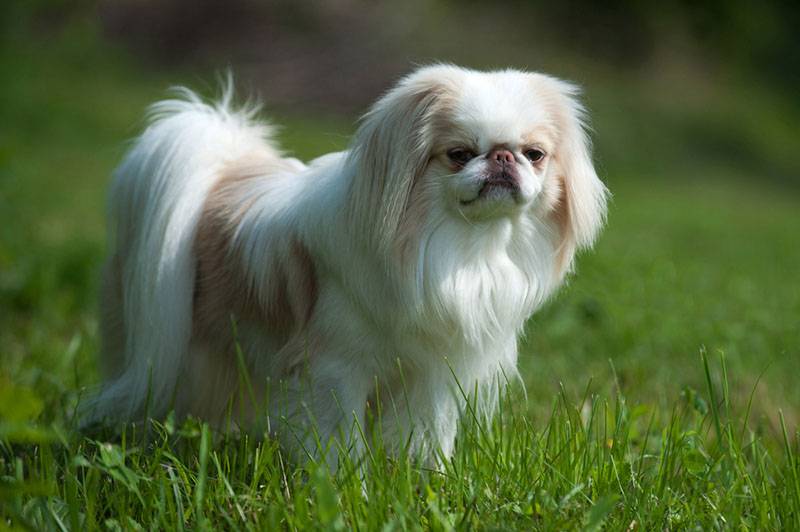
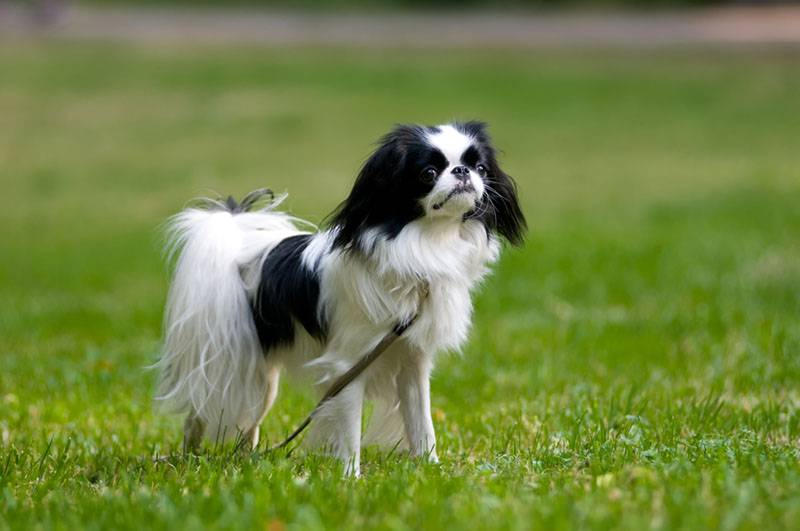
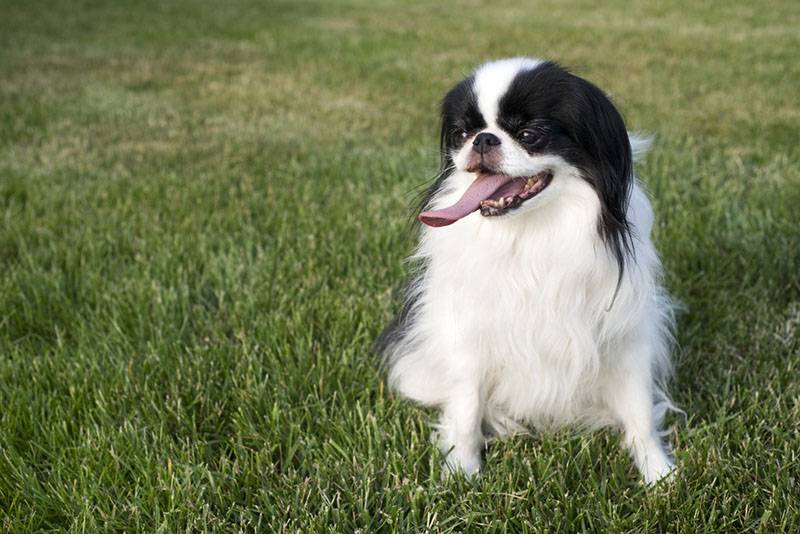
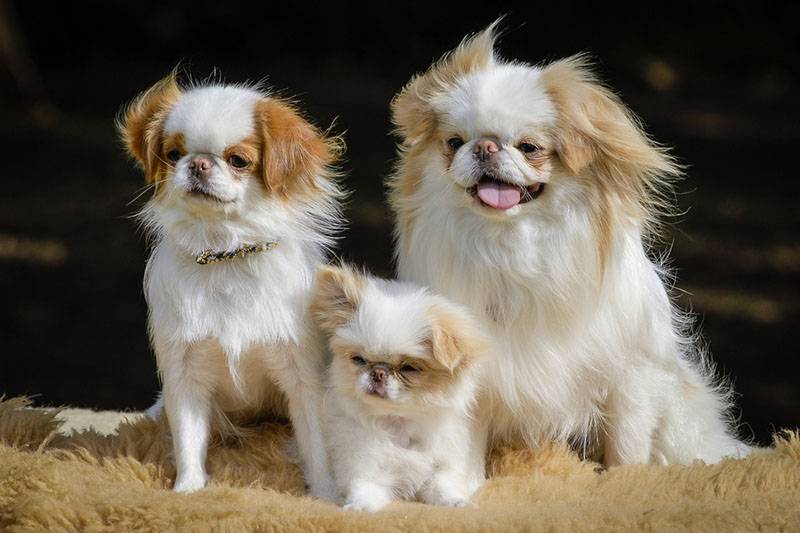
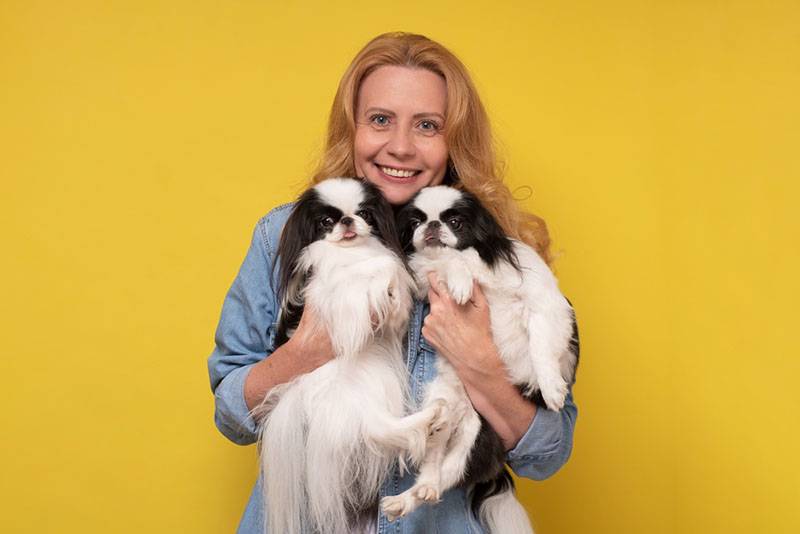
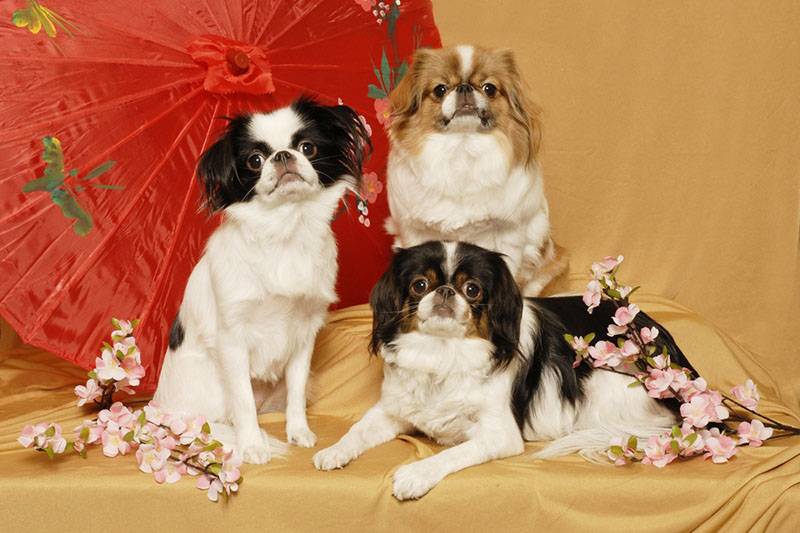
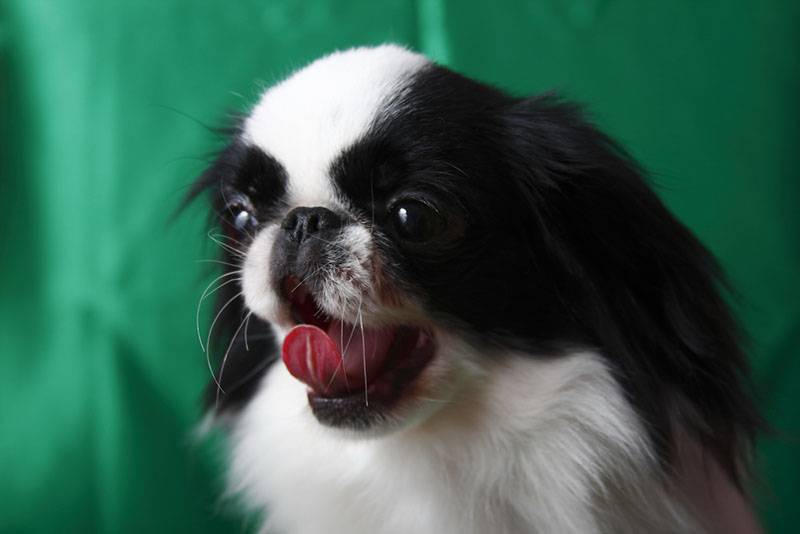
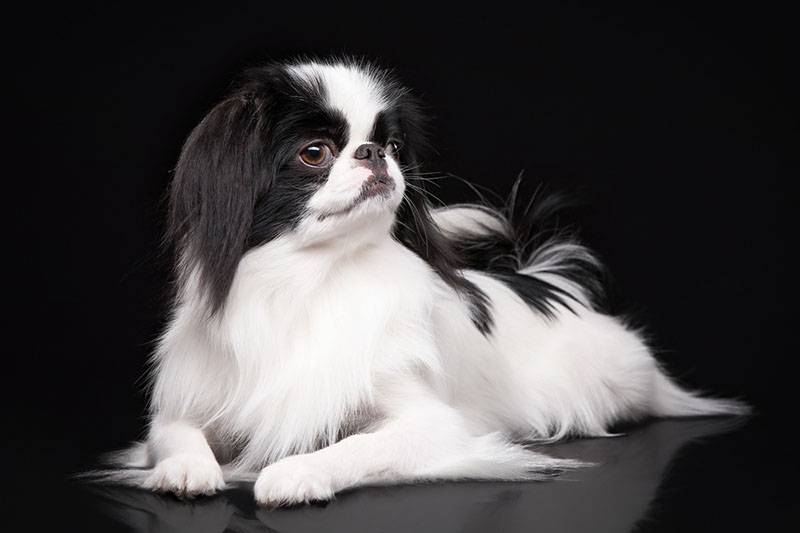
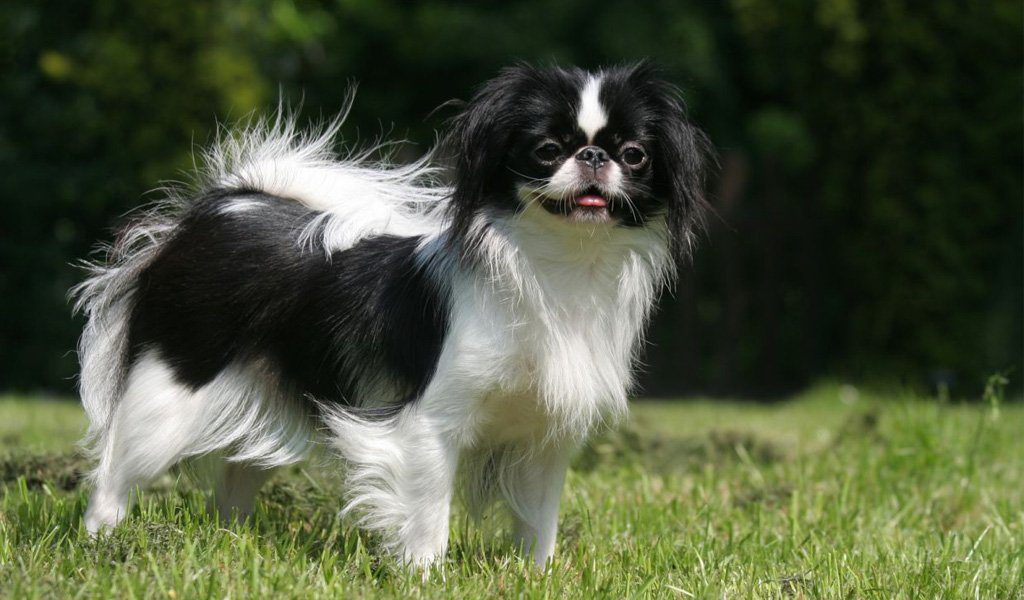
Japanese Chins , the animated treasures of Japanese and Chinese emperors, have long won the hearts of toy fanatics all over the world. They continue to touch the dog breeders with their grace and good looks. Their tender, fragile beauty, combined with intelligence, understanding, delicacy, sincere devotion and love for a person, demonstrate an amazing symbiosis, evoking in people a sense of beauty and a noble desire to take care of our smaller brothers.
| PROS Small size; They are well trained in new skills and commands; Easily get along with other pets and relatives; Affectionate and devoted. | CONS Poorly tolerate cold and heat; Not suitable for families with very young children; Snoring in their sleep; Wool is prone to tangles. |
History of the Japanese Chin
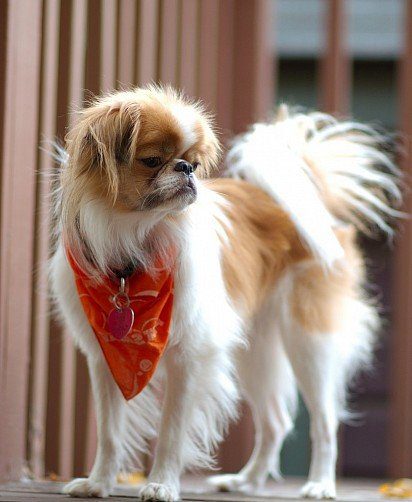
The fact that the Japanese Chin is one of the oldest dog breeds is indisputable, but versions of its origin are still being discussed. According to one of them, the breed is truly Japanese, another claims that the chins were brought to the Land of the Rising Sun from neighboring states of South Asia, but the routes by which they got there are not exactly known. There is a legend that a pair of dogs similar to the Japanese Chin was presented as a gift to the Japanese Emperor Semu by the ruler of one of the Korean states of Silla in 732. It is also possible that these dogs settled down at the Japanese imperial court as early as the 6th-7th centuries. The earliest possible date for the appearance of chins in Japan is the 3rd century, and in this case, India and China are considered exporting countries.
Recently, historians in the field of cynology have been inclined to believe that the Japanese Chin is one of the many breeds belonging to the so-called “toy” dogs of China, leading its ancestry from Tibetan dogs. Among them, in addition to the Chin, they also call Shih Tzu, Lhasa Apso, Pekingese, Pug, Tibetan Spaniel, which, by the way, has nothing to do with a hunting spaniel. All these animals are distinguished by a large head, large eyes, a short neck, a wide chest, thick hair – features that indicate their adaptability to the climate of the highlands. The version of the family ties connecting these dogs is confirmed by recent genetic studies. Graceful miniature dogs have been bred for centuries, living in Buddhist monasteries and imperial courts. It is known that the religious and secular elites of Tibet, China, Korea,
The first written sources describing the Japanese Chin date back to the 12th century. Like their relatives, they were considered sacred and were adored by their owners – crowned persons and representatives of the aristocracy. Legends were made about chins, their images adorned temples and luxurious porcelain vases, and craftsmen working with wood, ivory, and bronze embodied the image of these miniature animals when creating elegant figurines. Purposeful work on breeding this breed began in Japan in the XIV century, information was entered in stud books and kept in the strictest confidence. It is known that very miniature pets were most valued, easily fitting on small sofa cushions, in the sleeves of the kimono of noble ladies, they were even placed in suspended cages, like birds. In the 17th century, the daimyō families, the samurai elite, chose the chins as their talisman. Commoners were forbidden to keep Japanese chins, and their theft was equated with a state crime and was punishable by death.
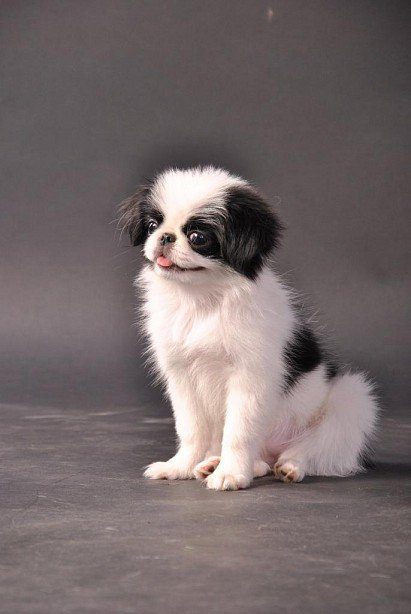
The origin of the breed name is also controversial. There is an opinion that the word “chin” comes from the Chinese almost consonant word for “dog”. According to another version, it comes from the Japanese “hii”, meaning “treasure”, “jewel”, which, by the way, fully corresponded to its status in terms of money.
According to some data, however, not fully specified, the first Japanese chins were brought to Europe in 1613 by Portuguese sailors. One of the dogs, or a couple, came to the court of the English king Charles II, where they became the favorites of his wife Catherine of Bragansk. Perhaps at the same time representatives of this breed appeared in Spain. More reliable information indicates that Japanese chins appeared in Europe and the New World thanks to US Navy Commodore Matthew Calbright Perry, who led an expedition to Japan in 1853 to establish trade relations. He delivered five of the chins presented to him by the Japanese emperor as a gift to his homeland, and one pair was presented to the English Queen Victoria.
The development of trade between Japan and European states, which began in the middle of the century before last, opened up the possibility of exporting chins to the continent, and systematic breeding of the breed began in many countries. In Europe, Japanese Chins quickly gained popularity as companion dogs and became the favorites of queens, empresses and ladies from high society. They inherited the tradition of the Japanese elite and presented their pets to each other as a gift. Khins prospered at the courts of all the royal families of Europe. The most famous lover of these dogs was the wife of the English monarch Edward VII, Queen Alexandra, who never for a moment parted with her many pets. The members of the family of Emperor Nicholas II also adored their little pets. By the way, the Soviet elite also favored this breed.
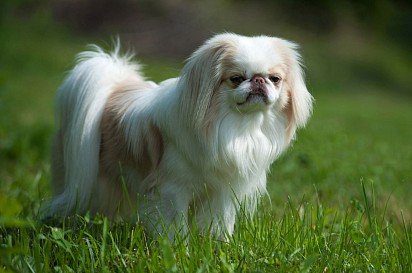
The breed was first shown at an exhibition in Birmingham in 1873. Here the Chin appeared under the name “Japanese Spaniel”. In the USA, this name was kept for dogs until 1977. The American Kennel Club recognized this breed under this name as early as 1888, and it is one of the earliest registered by this organization.
In the 1920s, systematic work was carried out to improve the Japanese Chin breed. Before the Second World War, selection was carried out in several directions. The largest representatives of the breed were called kobe, medium ones – yamato, and almost dwarf ones – edo. The appearance of modern chins retains the features of all three types of dogs.
The International Cynological Organization (FCI) recognized the Japanese Chin as a separate breed in 1957, placing it in the group of toy dogs and companion dogs.
In the Soviet Union, few people knew about the breed until the 80s of the last century, when six chins arrived in Moscow, presented as a gift to Russian diplomats at the end of their service in Japan. With the help of these dogs, Russian chinist enthusiasts set to work to improve and improve the breed. Today, in many nurseries in Moscow and St. Petersburg, Japanese chins are bred, whose ancestors were precisely these six souvenir animals.
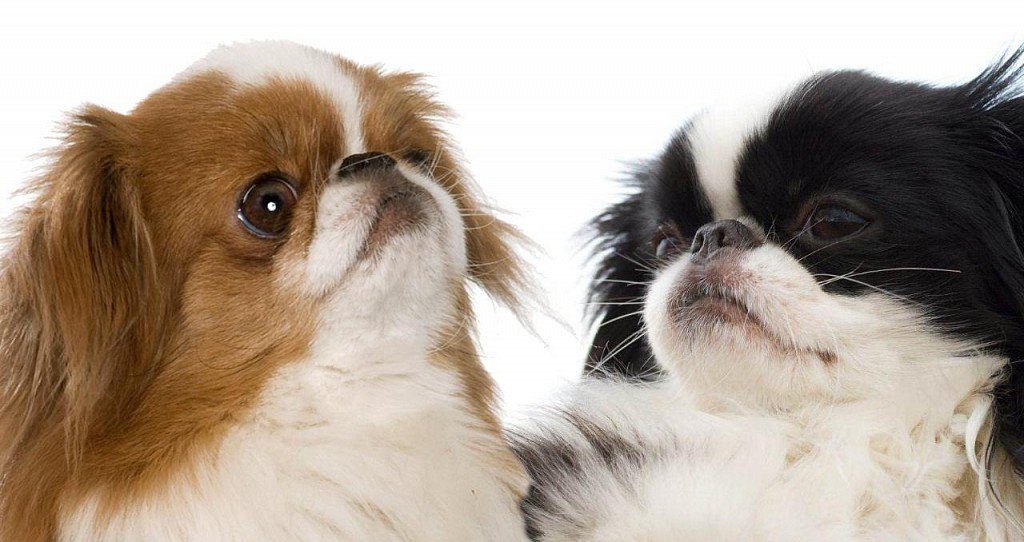
Video: Japanese Chin
Appearance of the Japanese Chin
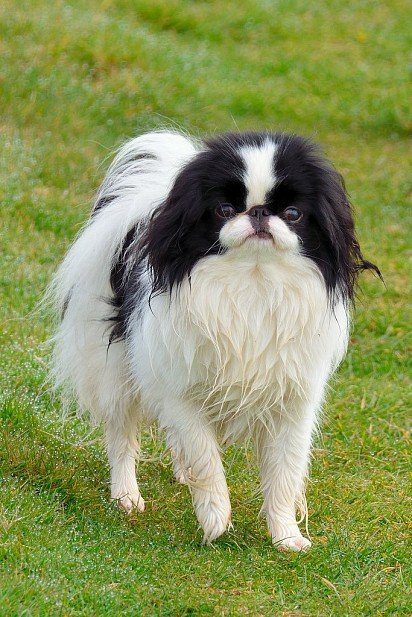

The Japanese Chin is distinguished by its tiny size and delicate constitution, and the smaller the dog within the standard, the more it is valued. These graceful dogs have a square format, determined by the equivalence of the height at the withers, which should not exceed 28 cm, and the length of the body. For females, some stretching of the body is acceptable.
Frame
The dog has a short and straight back with solid bones. The loin is wide, rounded. The chest is sufficiently voluminous, deep, the ribs are arched, moderately curved. The abdomen is tucked up.
Head
The skull has a wide, rounded shape, the line of transition from the forehead to the muzzle is sharp, the stop itself is deep, depressed. On a short, upturned muzzle, just above the upper lip, “pads” are clearly distinguished. The nose is in line with the eyes. Its color may be black or match the color of the color spots. Wide, open vertical nostrils facing forward.
Teeth and jaws
Teeth should be white and strong. Often there is a lack of teeth, the absence of lower incisors, which, however, according to the standard, is not included in the register of breed defects. A level bite is preferred, but underbite and scissor bite are also acceptable. Wide short jaws pushed forward.
Eyes
The round black and shiny eyes of the Japanese Chin are set wide apart. They should be expressive and large, but not huge and too prominent. Dogs belonging to purely Japanese breeding lines are characterized by an astonished expression of the muzzle. Such a cute feature is manifested due to the slanting, unfocused gaze of the animal, which is why whites are clearly visible in the corners of its eyes.
Ears
The triangular ears are set wide apart and covered with long hair. The ears hang down, deviating forward, but if the dog is alarmed by something, they rise slightly. The lining of the ear should be light, thin, and not heavy, like a spaniel.
Neck
The short neck of the Japanese Chin is characterized by a high set.
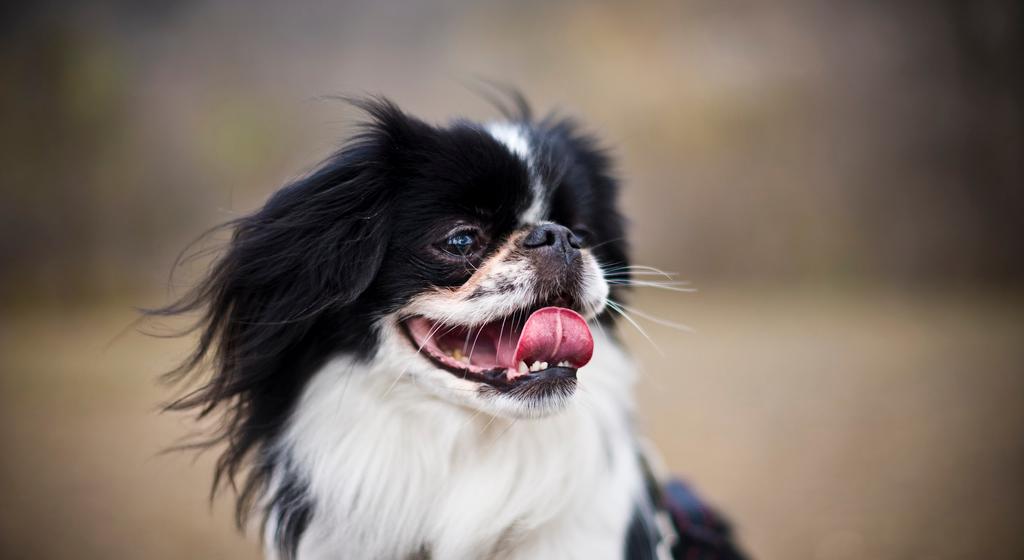

limbs
The forearms of the forelimbs are straight, thin-boned. The area below the elbow, behind, is covered by falling hair. For the forelimbs, let’s say the size, which gives the Japanese a reason to compare the dog with a person shod in geta – traditional shoes made of wood. Angles are visible on the hind legs, but they are moderately pronounced. The back of the thighs is covered with long hair.
Small paws have an elongated oval, hare, shape. The fingers are tightly clenched. It is desirable that there are fluffy tassels between them.
Traffic
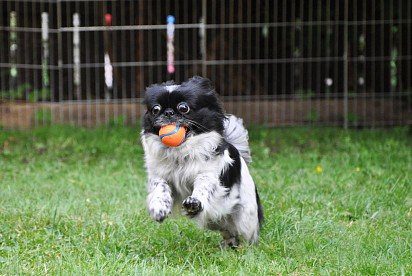

Chin moves elegantly, easily, proudly, measuredly, raising his paws high.
Tail
The tail, twisted into a ringlet, is thrown back. It is covered with spectacular long hair, falling and crumbling like a fan.
Wool
The Japanese Chin is the owner of a silky, straight, long coat, flowing like a fluffy cloak. The undercoat of the dog is practically absent. On the ears, tail, thighs, and especially on the neck, the hair grows more abundantly than on other parts of the body.
Color
The breed is characterized by a spotted black and white color or white with red spots. The second option implies any shades and intensity of red color for spots, for example, lemon, fawn, chocolate. It is undesirable to knit Japanese Chins with dark chocolate spots, as they often give birth to sick and even dead puppies.
The spots should be symmetrically distributed around the eyes, covering the ears and preferably the entire body, over which they can be randomly or balanced. The latter option is more preferable, as well as the presence of clear spot boundaries. It is very desirable to have such a detail as a white blaze, which should run from the bridge of the nose to the forehead, it may have a small black spot called the “finger of the Buddha”.
Defects and defects of the breed
- Hunchbacked or depressed back.
- In black and white dogs, the nose color is not black.
- Curvature of the lower jaw, undershot.
- Total white color with no spots, one spot on the muzzle.
- Painful fragility.
- Shy behavior, excessive fearfulness.
Photo of Japanese Chin
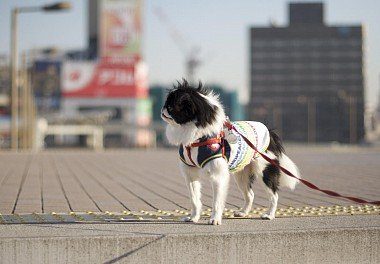

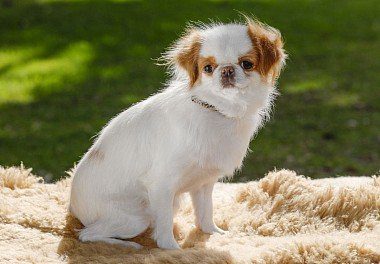

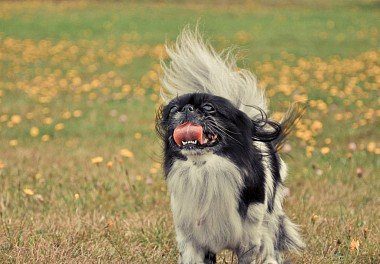

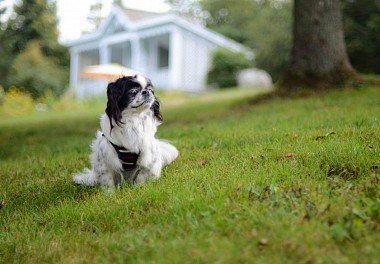

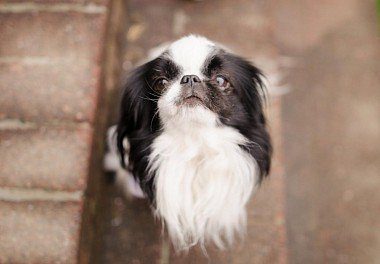

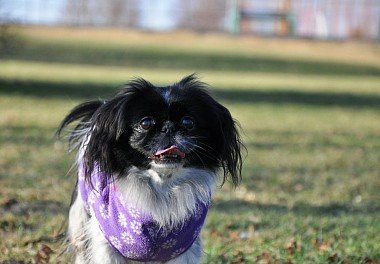

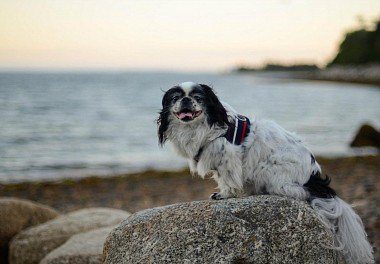

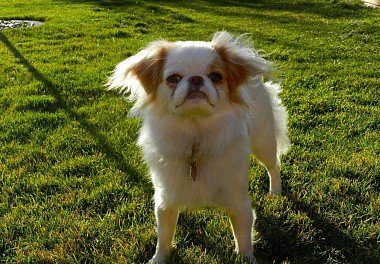

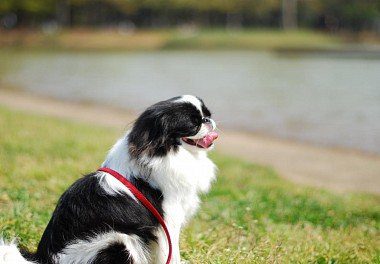

Character of the Japanese Chin
Japanese chins are distinguished by their intelligence, intelligence, and poise. They are mobile, but not fussy, unexpectedly courageous, and in case of danger to themselves or their owners, their courage can develop into recklessness. The dog never retreats in front of the enemy, but since it cannot enter into battle because of its size, it spits, yells or hisses like a cat. By the way, her resemblance to a cat also lies in the ability to meow, climb high surfaces, finding herself in the most unexpected places, and retire, finding a secluded corner. Khins are proud and unobtrusive – if the owners are busy, they will not bother, but simply wait delicately until they are paid attention to.
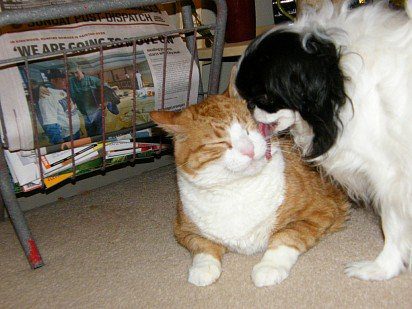

These dogs are exceptionally clean. They are always ready for washing and are able to take care of their fur on their own. If a couple of pets live in the house, then they will be happy to lick each other’s faces and clean their paws. Chins are completely non-malignant – they do not spoil furniture, do not gnaw cords and shoes, do not make much noise, and they bark infrequently.
Japanese Chins are incredibly proud and love to be admired. But they do not like familiarity, and they are wary of strangers, not allowing themselves to be touched. In the family circle, these dogs demonstrate love and friendliness, while choosing a favorite for themselves, whom they idolize. They treat other animals, including cats, kindly, they are not afraid of large dogs. Chins get along well with children, but it is not recommended to keep them in a family where the baby is growing up: a child, through negligence, can injure the animal.
Moderate activity and balanced temperament allow the Japanese Chin to feel comfortable in any family. With owners who prefer an active lifestyle, he will gladly go for a long walk or jog, go swimming, with couch potatoes or the elderly, he will share a place on the couch, buried in a bunch of plush pillows. Unobtrusive and delicate, Chin is an excellent companion for people who are prone to loneliness. However, all owners should take into account that these gentle dogs must know that they are sincerely loved, otherwise they will feel completely miserable.
Khins love to travel and accept any means of transportation, be it a car, a motorboat, or an airplane. A bicycle basket will suit them just as well.
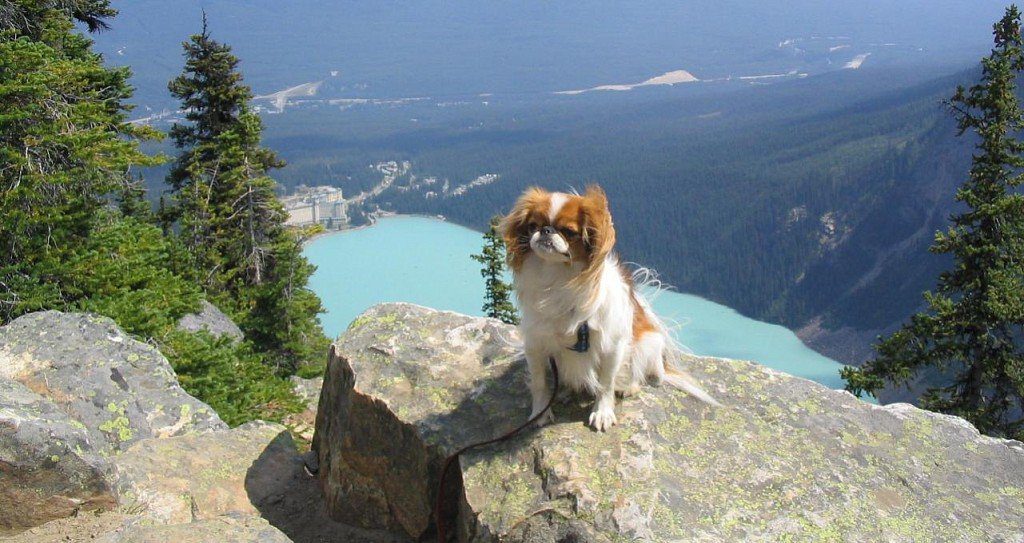

Education and training of the Japanese Chin
Despite its small size, the Japanese Chin, like any other dog, needs training and education. Pets learn commands easily, and if desired, they can be taught to perform various funny tricks.
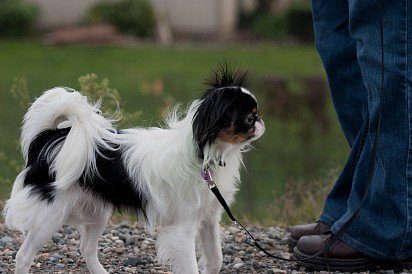

During classes, it is unacceptable to raise your voice to the dog and, moreover, to use physical punishment. It is advisable not to touch roughly the muzzle and tail of the animal during the training process. You should also not make sudden movements – this can disorient him and even provoke aggression. Lessons are best done in the form of a game, while you should not be zealous with repetitions of the same command, let the hin perform it five or six times during the lesson – this will be enough.
It has been observed that among the Japanese Chins, there are very few pets that dog owners call food workers because they are trained with the help of encouraging treats. But praising the dog, gently calling it affectionate names, is necessary – this will only help it to fully show its quick wits.
Care and maintenance
Caring for a clean and unpretentious chin is absolutely simple. It is desirable, of course, to take him for a walk three times a day, but it is permissible to limit himself to one walk, accustoming the dog to a home toilet tray. In bad weather, you can take a walk with the dog, holding it in your arms or dress your pet in waterproof overalls. In the hot season, it is advisable to walk the dog in the shade, because from overheating it can begin to suffocate. For walks with a chin, choose not a collar, but a chest harness – a kind of harness, since its neck is quite tender. Please note that these dogs, being without a leash, may well climb the first height that comes across, for example, a children’s slide, so you need to make sure that a small pet does not fall, crippling itself.
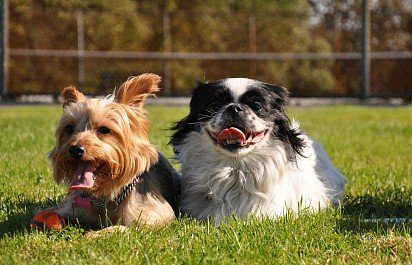

The coat of the Japanese Chin is also easy to care for. He does not need model hairstyles, and the haircut is only hygienic, requiring only the removal of regrown hairs. It would be nice to comb your pet daily, in any case, this procedure should be done at least twice a week, accustoming a dog to it from puppyhood.
They bathe the chin as needed, but not more than once every two weeks. Paws and ears are washed as they become dirty. For bathing, use zoo shampoos, which, in addition to the washing effect, also have antimicrobial, antiparasitic properties. After shampooing, treat the dog’s coat with conditioner – this will fluff it up and smell nice. After the procedure, the Japanese chin must be dried so that it does not catch a cold. You can use a towel or hairdryer.
As an alternative to bathing, you can use the dry method of cleaning the animal’s hair using a special powder. Some owners use talcum powder or baby powder for this procedure. The product should be gently rubbed into the pet’s fur, making sure that some part of it gets on his skin. After powdering, carefully comb the animal’s fur until the powder disappears completely. This method allows you to effectively clean the coat from dirt and dead hair.
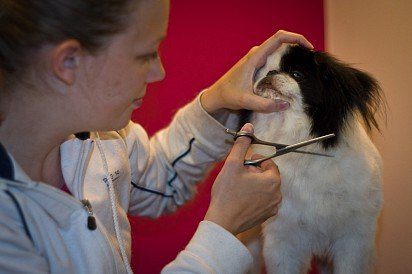

The claws of Japanese Chins grow very quickly, while they are bent, exfoliated, which causes discomfort to the dog. They should be cut with a nail cutter as they grow, as a rule, at least once a month. For this cosmetic procedure, the dog will be especially grateful to the owner.
Chin nutrition should be high in calories. These dogs do not eat much, but they move very actively, even living in an apartment. The diet should include foods that contain sufficient amounts of protein and calcium. For animals of this breed, the following products are preferred, which must be alternated: turkey meat, chicken, lean beef, boiled liver, tripe, kidneys, sea fish (no more than 1 time per week), boiled yolk (two to three times a week). Periodically, you need to give rice, boiled vegetables, raw pitted fruits.
The finished food should be premium or holistic.
It is important not to overfeed the Chin, because he quickly gains excess weight, and this negatively affects his health.
It is advisable that the gentle Japanese chin be periodically examined by a veterinarian for prevention. For older animals, a regular veterinary examination is recommended.
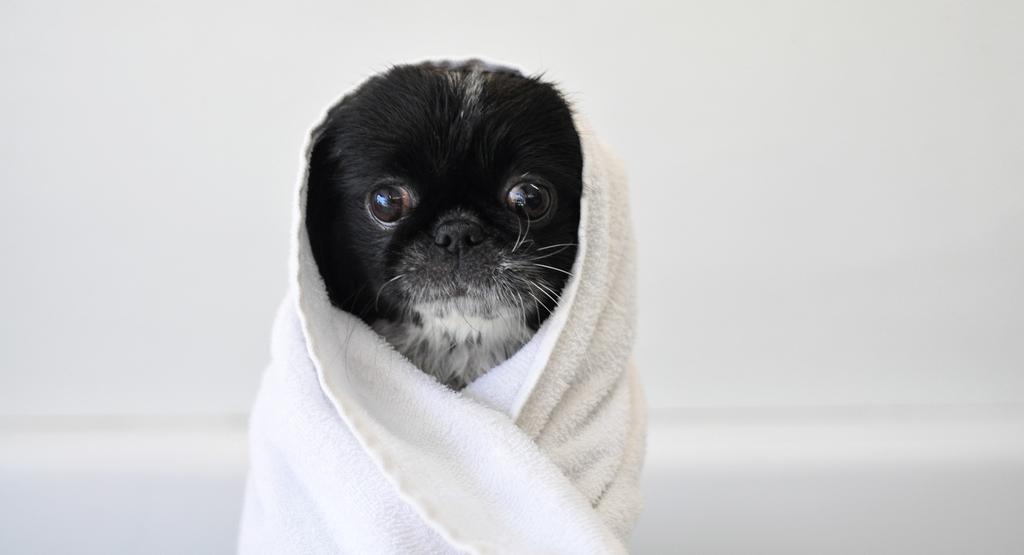

Japanese Chin health and disease
Japanese Chins, despite their slenderness, cannot be called sickly dogs, and the main ailments that are characteristic of these animals are characteristic of most of all small dog breeds. However, there are a number of diseases associated specifically with breed predisposition and heredity, and this is not an accident.
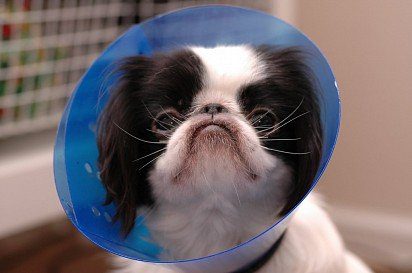

The original, striking features of the appearance of chins have been formed since time immemorial, appearing unexpectedly and attracting ancient breeders from South Asia and the Far East. Dogs with a distinctive appearance were used for mating, but their expressive external features were associated with nothing more than mutations that gradually change the gene code of the breed. The cute “highlights” of the appearance of the Japanese Chins were confidently passed down from generation to generation, and today are imprinted in the breed standard. However, being not harmless in their biological basis, they can be the source of serious diseases. Fortunately, not every dog inherits abnormal genes.
Among the Japanese Chins, as well as among their fellow tribesmen with a flat muzzle, that is, shortened facial bones of the skull, brachycephalic syndrome is widespread – a change in the structure of the upper respiratory tract, leading to disruption of their work. Even at a comfortable air temperature, these babies have difficulty breathing, and it is especially hard for them to breathe in heat and cold. In hot weather, they can suffer from heat stroke.


In the first weeks of life, Japanese Chin puppies sometimes experience dropsy of the brain, which in some cases can lead to fatal consequences. Rare, but possible diseases include GM2 gangliosidosis, a hereditary defect that catastrophically disrupts the functioning of the central nervous system.
Another possible genetic anomaly is distichiasis, which manifests itself in the formation of an additional row of eyelashes, which leads to irritation of the mucous membrane of the eyeball and can cause permanent tearing, strabismus, corneal erosion and ulceration. Among other eye diseases, cataracts, progressive retinal atrophy, and inversion of the eyelid are common.
Disturbances in the function of the endocrine system, combined with the specifics of genetics, are manifested in the Japanese Chin in the distortion of the jaw, polydentation or false polyodontia, which occurs due to a delay in the loss of milk teeth. Failure of the dental system, in turn, leads to dysfunction of the digestive system.
Among the defects inherent in small breeds of dogs, which are also characteristic of the Japanese Chin, are the underdevelopment of the reproductive system, as well as disruption of the musculoskeletal system, which manifests itself in frequent dislocations of the patella and necrosis of the femoral head. Excessive curvature of the tail can cause suffering to dogs.
It should be borne in mind that after 8 years, when the childbearing age ends in bitches, they begin to age, lose teeth, they often experience exacerbations of chronic ailments. From the age of 10, Chins often have hearing problems.
You need to know about one more feature of the breed – these dogs do not tolerate anesthesia very well.
How to choose a puppy
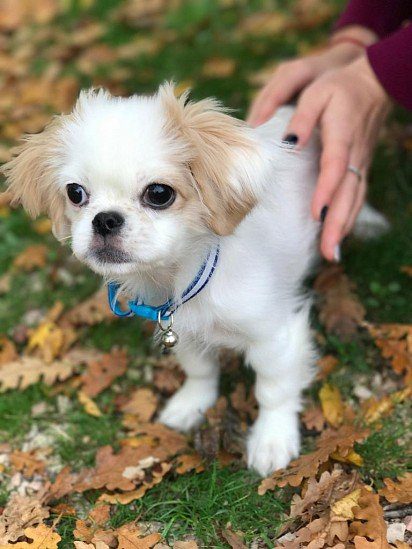

Whatever Japanese Chin puppy you decide to buy – a show class dog or just a pet, it is important, first of all, to choose a seller. They can become a reliable, responsible breeder, and ideally, the owner of a breeding nursery that has a good reputation and a documented history of breeding the breed in this particular nursery. Professionals in their field will always pick up exactly the puppy you dream of, issue documents confirming that he is healthy, a certificate of pedigree, a description of his potential breeding qualities.
To begin with, make sure that the puppies are kept in a clean room, watch them. Check if all puppies from one litter look healthy, if they are active, if they are well fed. Look at the baby that you liked more than the rest from head to tail. Make sure that his ears are clean, without redness, his eyes are clear, mischievous, his gums are pink, his teeth are white, his coat is silky, shiny. Suspicion should be raised by any sign of undershot bite and overbite.
Look closely at the chin you like as it plays. Such an observation will help to notice whether conspicuous vices are characteristic of him: the “cow” position of the hind limbs, their instability, and an excessively lowered sternum. These shortcomings are rarely leveled with age.
It is very important to make sure that the parents of your potential pet do not have diseases, and also to clarify whether the bitch was sick during pregnancy, as in this case the puppies may develop pathologies, including such a dangerous disease as hydrocephalus. You also need to look closely at the mother of the puppy, and if you choose a Japanese chin with a show perspective, it is advisable to see both parents.
Photo of Japanese Chin puppies
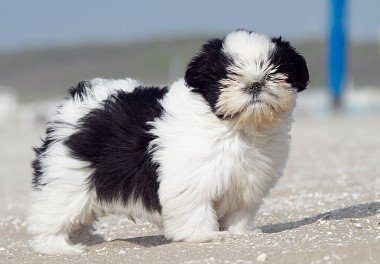

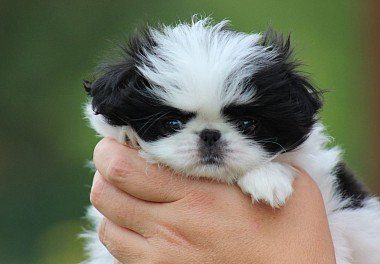

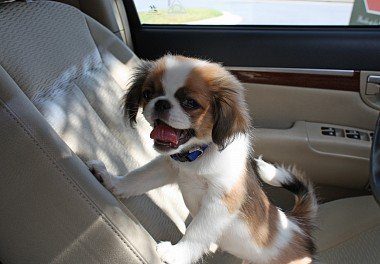

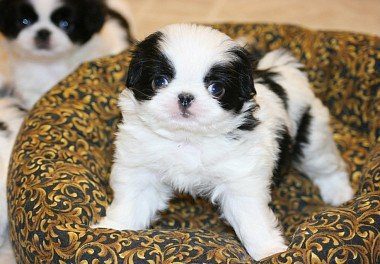

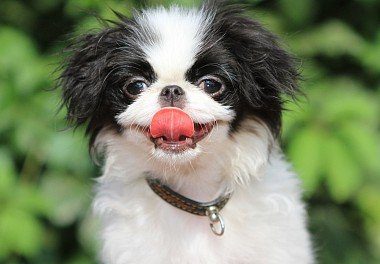

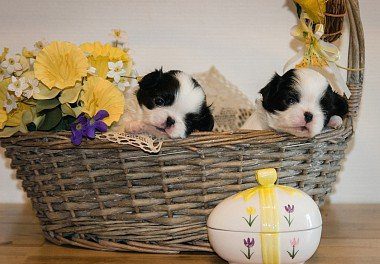

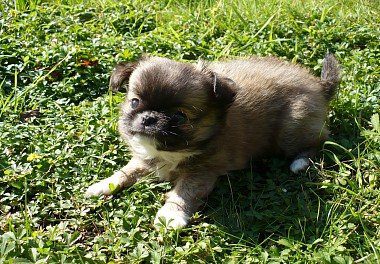

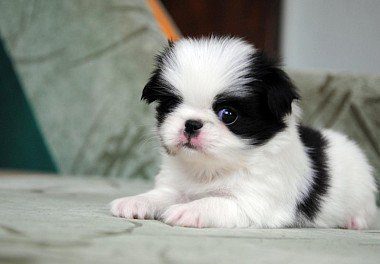

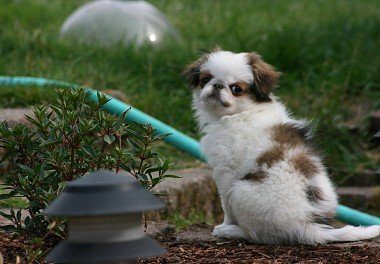

How much is the Japanese Chin
You can buy a Japanese chin “from hand” for an amount of 100 to 150$. But in this case, you run the risk of acquiring a pet whose purity will be in question. The baby may be mestizo. In the best case, among his parents will be a Pekingese, which unscrupulous breeders often mate with a more expensive chin.
In kennels, pet class puppies cost from 150$, babies of the most popular breed class – from 250$. Show class dogs with exhibition prospects cost at least 400$. The best of them can be sold for more than 1000$.
Prices in various nurseries vary and depend on their location, the reputation of the owners, the breeding fund.





